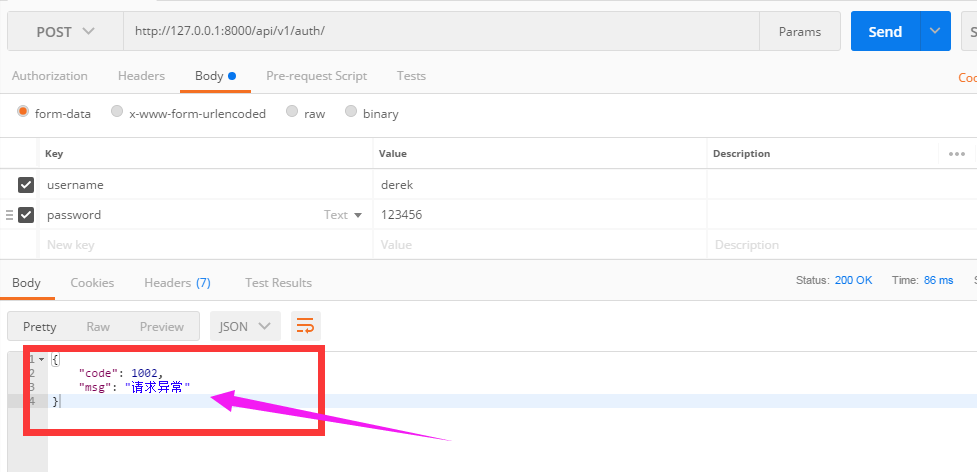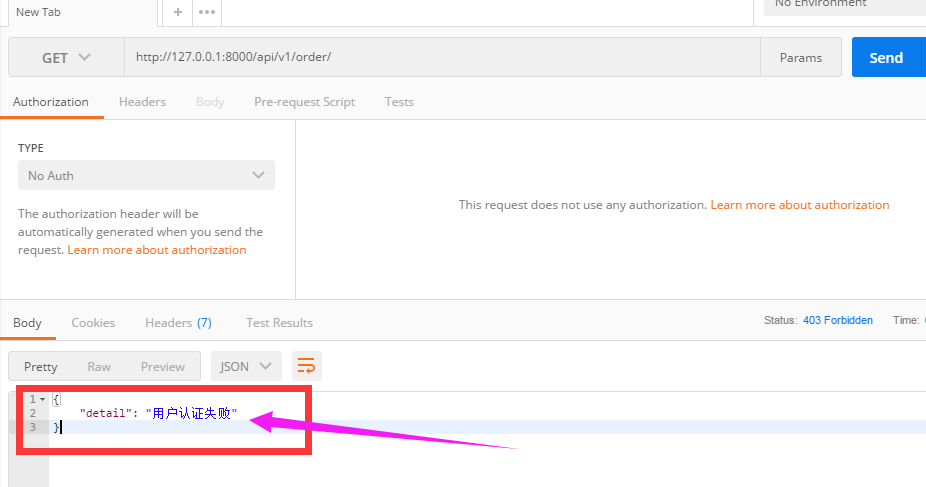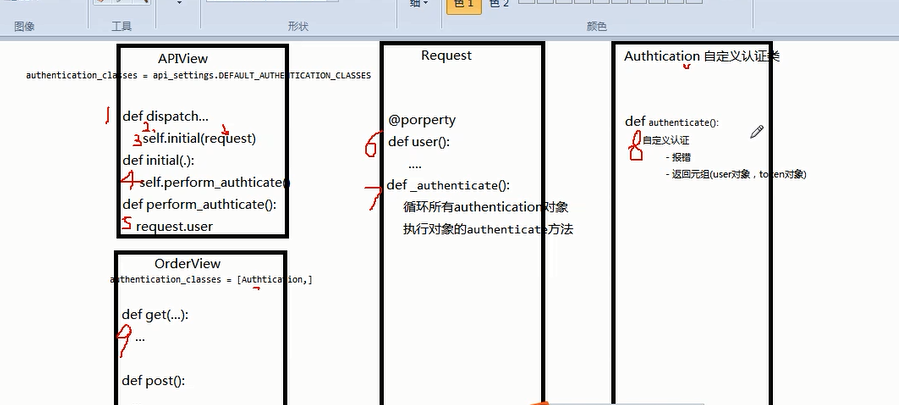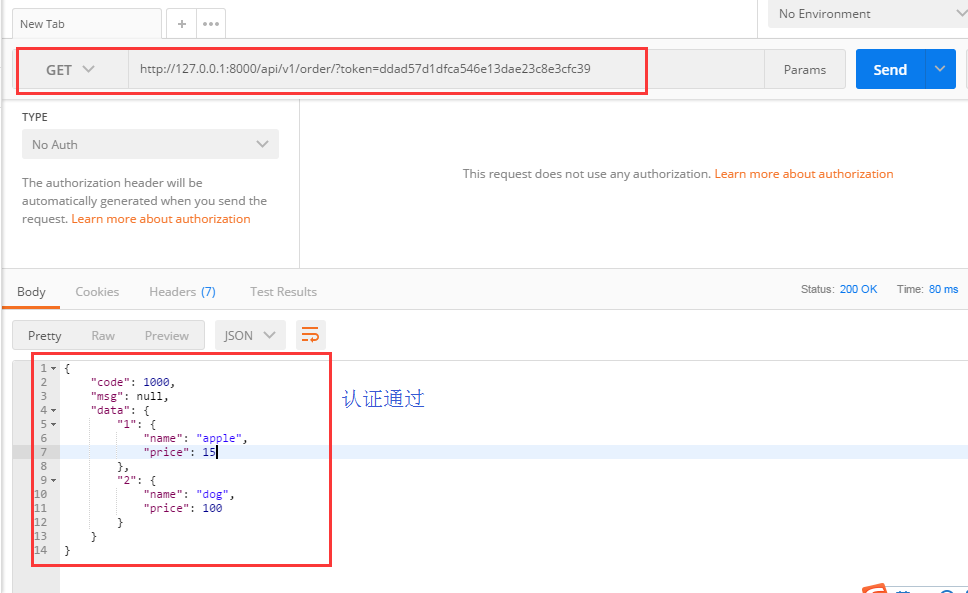目录
- Django rest framework(1)----认证
- Django rest framework(2)----权限
- Django rest framework(3)----节流
- Django rest framework(4)----版本
- Django rest framework(5)----解析器
- Django rest framework(6)----序列化
- Django rest framework(7)----分页
一、基础
1.1.安装
两种方式:
- github
- pip直接安装
pip install djangorestframework
1.2.需要先了解的一些知识
理解下面两个知识点非常重要,django-rest-framework源码中到处都是基于CBV和面向对象的封装
(1)面向对象封装的两大特性
把同一类方法封装到类中
将数据封装到对象中
(2)CBV
基于反射实现根据请求方式不同,执行不同的方法
原理:url-->view方法-->dispatch方法(反射执行其它方法:GET/POST/PUT/DELETE等等)
二、简单实例
2.1.settings
先创建一个project和一个app(我这里命名为API)
首先要在settings的app中添加
INSTALLED_APPS = [ 'rest_framework', ]
2.2.url
from django.contrib import admin from django.urls import path from API.views import AuthView urlpatterns = [ path('admin/', admin.site.urls), path('api/v1/auth/',AuthView.as_view()), ]
2.3.models
一个保存用户的信息
一个保存用户登录成功后的token
from django.db import models class UserInfo(models.Model): USER_TYPE = ( (1,'普通用户'), (2,'VIP'), (3,'SVIP') ) user_type = models.IntegerField(choices=USER_TYPE) username = models.CharField(max_length=32) password = models.CharField(max_length=64) class UserToken(models.Model): user = models.OneToOneField(UserInfo,on_delete=models.CASCADE) token = models.CharField(max_length=64)
2.4.views
用户登录(返回token并保存到数据库)
from django.shortcuts import render from django.http import JsonResponse from rest_framework.views import APIView from API import models def md5(user): import hashlib import time #当前时间,相当于生成一个随机的字符串 ctime = str(time.time()) m = hashlib.md5(bytes(user,encoding='utf-8')) m.update(bytes(ctime,encoding='utf-8')) return m.hexdigest() class AuthView(object): def post(self,request,*args,**kwargs): ret = {'code':1000,'msg':None} try: user = request._request.POST.get('username') pwd = request._request.POST.get('password') obj = models.UserInfo.objects.filter(username=user,password=pwd).first() if not obj: ret['code'] = 1001 ret['msg'] = '用户名或密码错误' #为用户创建token token = md5(user) #存在就更新,不存在就创建 models.UserToken.objects.update_or_create(user=obj,defaults={'token':token}) ret['token'] = token except Exception as e: ret['code'] = 1002 ret['msg'] = '请求异常' return JsonResponse(ret)
2.5.利用postman发请求

如果用户名和密码正确的话 会生成token值,下次该用户再登录时,token的值就会更新
数据库中可以看到token的值

当用户名或密码错误时,抛出异常

三、添加认证
基于上面的例子,添加一个认证的类
3.1.url
path('api/v1/order/',OrderView.as_view()),
3.2.views
from django.shortcuts import render,HttpResponse from django.http import JsonResponse from rest_framework.views import APIView from API import models from rest_framework.request import Request from rest_framework import exceptions from rest_framework.authentication import BasicAuthentication ORDER_DICT = { 1:{ 'name':'apple', 'price':15 }, 2:{ 'name':'dog', 'price':100 } } def md5(user): import hashlib import time #当前时间,相当于生成一个随机的字符串 ctime = str(time.time()) m = hashlib.md5(bytes(user,encoding='utf-8')) m.update(bytes(ctime,encoding='utf-8')) return m.hexdigest() class AuthView(object): '''用于用户登录验证''' def post(self,request,*args,**kwargs): ret = {'code':1000,'msg':None} try: user = request._request.POST.get('username') pwd = request._request.POST.get('password') obj = models.UserInfo.objects.filter(username=user,password=pwd).first() if not obj: ret['code'] = 1001 ret['msg'] = '用户名或密码错误' #为用户创建token token = md5(user) #存在就更新,不存在就创建 models.UserToken.objects.update_or_create(user=obj,defaults={'token':token}) ret['token'] = token except Exception as e: ret['code'] = 1002 ret['msg'] = '请求异常' return JsonResponse(ret) class Authentication(APIView): '''认证''' def authenticate(self,request): token = request._request.GET.get('token') token_obj = models.UserToken.objects.filter(token=token).first() if not token_obj: raise exceptions.AuthenticationFailed('用户认证失败') #在rest framework内部会将这两个字段赋值给request,以供后续操作使用 return (token_obj.user,token_obj) def authenticate_header(self, request): pass class OrderView(APIView): '''订单相关业务''' authentication_classes = [Authentication,] #添加认证 def get(self,request,*args,**kwargs): #request.user #request.auth ret = {'code':1000,'msg':None,'data':None} try: ret['data'] = ORDER_DICT except Exception as e: pass return JsonResponse(ret)
3.3用postman发get请求
请求的时候没有带token,可以看到会显示“用户认证失败”

这样就达到了认证的效果,django-rest-framework的认证是怎么实现的呢,下面基于这个例子来剖析drf的源码。
四、drf的认证源码分析
源码流程图

请求先到dispatch
dispatch()主要做了两件事
- 封装request
- 认证
具体看我写的代码里面的注释
def dispatch(self, request, *args, **kwargs): """ `.dispatch()` is pretty much the same as Django's regular dispatch, but with extra hooks for startup, finalize, and exception handling. """ self.args = args self.kwargs = kwargs #对原始request进行加工,丰富了一些功能 #Request( # request, # parsers=self.get_parsers(), # authenticators=self.get_authenticators(), # negotiator=self.get_content_negotiator(), # parser_context=parser_context # ) #request(原始request,[BasicAuthentications对象,]) #获取原生request,request._request #获取认证类的对象,request.authticators #1.封装request request = self.initialize_request(request, *args, **kwargs) self.request = request self.headers = self.default_response_headers # deprecate? try: #2.认证 self.initial(request, *args, **kwargs) # Get the appropriate handler method if request.method.lower() in self.http_method_names: handler = getattr(self, request.method.lower(), self.http_method_not_allowed) else: handler = self.http_method_not_allowed response = handler(request, *args, **kwargs) except Exception as exc: response = self.handle_exception(exc) self.response = self.finalize_response(request, response, *args, **kwargs) return self.response
4.1.reuqest
(1)initialize_request()
可以看到initialize()就是封装原始request
def initialize_request(self, request, *args, **kwargs): """ Returns the initial request object. """ parser_context = self.get_parser_context(request) return Request( request, parsers=self.get_parsers(), authenticators=self.get_authenticators(), #[BasicAuthentication(),],把对象封装到request里面了
negotiator=self.get_content_negotiator(), parser_context=parser_context )
(2)get_authenticators()
通过列表生成式,返回对象的列表
def get_authenticators(self): """ Instantiates and returns the list of authenticators that this view can use. """ return [auth() for auth in self.authentication_classes]
(3)authentication_classes
APIView里面有个 authentication_classes 字段
可以看到默认是去全局的配置文件找(api_settings)
class APIView(View): # The following policies may be set at either globally, or per-view. renderer_classes = api_settings.DEFAULT_RENDERER_CLASSES parser_classes = api_settings.DEFAULT_PARSER_CLASSES authentication_classes = api_settings.DEFAULT_AUTHENTICATION_CLASSES throttle_classes = api_settings.DEFAULT_THROTTLE_CLASSES permission_classes = api_settings.DEFAULT_PERMISSION_CLASSES content_negotiation_class = api_settings.DEFAULT_CONTENT_NEGOTIATION_CLASS metadata_class = api_settings.DEFAULT_METADATA_CLASS versioning_class = api_settings.DEFAULT_VERSIONING_CLASS
4.2.认证
self.initial(request, *args, **kwargs)
def dispatch(self, request, *args, **kwargs): """ `.dispatch()` is pretty much the same as Django's regular dispatch, but with extra hooks for startup, finalize, and exception handling. """ self.args = args self.kwargs = kwargs #对原始request进行加工,丰富了一些功能 #Request( # request, # parsers=self.get_parsers(), # authenticators=self.get_authenticators(), # negotiator=self.get_content_negotiator(), # parser_context=parser_context # ) #request(原始request,[BasicAuthentications对象,]) #获取原生request,request._request #获取认证类的对象,request.authticators #1.封装request request = self.initialize_request(request, *args, **kwargs) self.request = request self.headers = self.default_response_headers # deprecate? try: #2.认证 self.initial(request, *args, **kwargs) # Get the appropriate handler method if request.method.lower() in self.http_method_names: handler = getattr(self, request.method.lower(), self.http_method_not_allowed) else: handler = self.http_method_not_allowed response = handler(request, *args, **kwargs) except Exception as exc: response = self.handle_exception(exc) self.response = self.finalize_response(request, response, *args, **kwargs) return self.response
(1)initial()
主要看 self.perform_authentication(request),实现认证
def initial(self, request, *args, **kwargs): """ Runs anything that needs to occur prior to calling the method handler. """ self.format_kwarg = self.get_format_suffix(**kwargs) # Perform content negotiation and store the accepted info on the request neg = self.perform_content_negotiation(request) request.accepted_renderer, request.accepted_media_type = neg # Determine the API version, if versioning is in use. version, scheme = self.determine_version(request, *args, **kwargs) request.version, request.versioning_scheme = version, scheme # Ensure that the incoming request is permitted #3.实现认证 self.perform_authentication(request) self.check_permissions(request) self.check_throttles(request)
(2)perform_authentication()
调用了request.user
def perform_authentication(self, request): """ Perform authentication on the incoming request. Note that if you override this and simply 'pass', then authentication will instead be performed lazily, the first time either `request.user` or `request.auth` is accessed. """ request.user
(3)user
request.user的request的位置

点进去可以看到Request有个user方法,加 @property 表示调用user方法的时候不需要加括号“user()”,可以直接调用:request.user
@property def user(self): """ Returns the user associated with the current request, as authenticated by the authentication classes provided to the request. """ if not hasattr(self, '_user'): with wrap_attributeerrors(): #获取认证对象,进行一步步的认证 self._authenticate() return self._user
(4)_authenticate()
循环所有authenticator对象
def _authenticate(self): """ Attempt to authenticate the request using each authentication instance in turn. """ #循环认证类的所有对象 #执行对象的authenticate方法 for authenticator in self.authenticators: try: #执行认证类的authenticate方法 #这里分三种情况 #1.如果authenticate方法抛出异常,self._not_authenticated()执行 #2.有返回值,必须是元组:(request.user,request.auth) #3.返回None,表示当前认证不处理,等下一个认证来处理 user_auth_tuple = authenticator.authenticate(self) except exceptions.APIException: self._not_authenticated() raise if user_auth_tuple is not None: self._authenticator = authenticator self.user, self.auth = user_auth_tuple return self._not_authenticated()
返回值就是例子中的:
token_obj.user-->>request.user
token_obj-->>request.auth
#在rest framework内部会将这两个字段赋值给request,以供后续操作使用 return (token_obj.user,token_obj) #例子中的return
当都没有返回值,就执行self._not_authenticated(),相当于匿名用户,没有通过认证
def _not_authenticated(self): """ Set authenticator, user & authtoken representing an unauthenticated request. Defaults are None, AnonymousUser & None. """ self._authenticator = None if api_settings.UNAUTHENTICATED_USER: self.user = api_settings.UNAUTHENTICATED_USER() #AnonymousUser匿名用户 else: self.user = None if api_settings.UNAUTHENTICATED_TOKEN: self.auth = api_settings.UNAUTHENTICATED_TOKEN() #None else: self.auth = None
面向对象知识:
子类继承 父类,调用方法的时候:
- 优先去自己里面找有没有这个方法,有就执行自己的
- 只有当自己里面没有这个方法的时候才会去父类找
因为authenticate方法我们自己写,所以当执行authenticate()的时候就是执行我们自己写的认证
父类中的authenticate方法
def authenticate(self, request): return (self.force_user, self.force_token)
我们自己写的
class Authentication(APIView): '''用于用户登录验证''' def authenticate(self,request): token = request._request.GET.get('token') token_obj = models.UserToken.objects.filter(token=token).first() if not token_obj: raise exceptions.AuthenticationFailed('用户认证失败') #在rest framework内部会将这两个字段赋值给request,以供后续操作使用 return (token_obj.user,token_obj)
认证的流程就是上面写的,弄懂了原理,再写代码就更容易理解为什么了。
4.3.配置文件
继续解读源码

默认是去全局配置文件中找,所以我们应该在settings.py中配置好路径
api_settings源码
api_settings = APISettings(None, DEFAULTS, IMPORT_STRINGS) def reload_api_settings(*args, **kwargs): setting = kwargs['setting'] if setting == 'REST_FRAMEWORK': api_settings.reload()
setting中‘REST_FRAMEWORK’中找
全局配置方法:
API文件夹下面新建文件夹utils,再新建auth.py文件,里面写上认证的类
settings.py
#设置全局认证 REST_FRAMEWORK = { "DEFAULT_AUTHENTICATION_CLASSES":['API.utils.auth.Authentication',] #里面写你的认证的类的路径 }
auth.py
# API/utils/auth.py from rest_framework import exceptions from API import models class Authentication(object): '''用于用户登录验证''' def authenticate(self,request): token = request._request.GET.get('token') token_obj = models.UserToken.objects.filter(token=token).first() if not token_obj: raise exceptions.AuthenticationFailed('用户认证失败') #在rest framework内部会将这两个字段赋值给request,以供后续操作使用 return (token_obj.user,token_obj) def authenticate_header(self, request): pass
在settings里面设置的全局认证,所有业务都需要经过认证,如果想让某个不需要认证,只需要在其中添加下面的代码:
authentication_classes = [] #里面为空,代表不需要认证

from django.shortcuts import render,HttpResponse from django.http import JsonResponse from rest_framework.views import APIView from API import models from rest_framework.request import Request from rest_framework import exceptions from rest_framework.authentication import BasicAuthentication ORDER_DICT = { 1:{ 'name':'apple', 'price':15 }, 2:{ 'name':'dog', 'price':100 } } def md5(user): import hashlib import time #当前时间,相当于生成一个随机的字符串 ctime = str(time.time()) m = hashlib.md5(bytes(user,encoding='utf-8')) m.update(bytes(ctime,encoding='utf-8')) return m.hexdigest() class AuthView(APIView): '''用于用户登录验证''' authentication_classes = [] #里面为空,代表不需要认证 def post(self,request,*args,**kwargs): ret = {'code':1000,'msg':None} try: user = request._request.POST.get('username') pwd = request._request.POST.get('password') obj = models.UserInfo.objects.filter(username=user,password=pwd).first() if not obj: ret['code'] = 1001 ret['msg'] = '用户名或密码错误' #为用户创建token token = md5(user) #存在就更新,不存在就创建 models.UserToken.objects.update_or_create(user=obj,defaults={'token':token}) ret['token'] = token except Exception as e: ret['code'] = 1002 ret['msg'] = '请求异常' return JsonResponse(ret) class OrderView(APIView): '''订单相关业务''' def get(self,request,*args,**kwargs): # self.dispatch #request.user #request.auth ret = {'code':1000,'msg':None,'data':None} try: ret['data'] = ORDER_DICT except Exception as e: pass return JsonResponse(ret)
再测试一下我们的代码
不带token发请求

带token发请求

五、drf的内置认证
rest_framework里面内置了一些认证,我们自己写的认证类都要继承内置认证类 "BaseAuthentication"
4.1.BaseAuthentication源码:
class BaseAuthentication(object): """ All authentication classes should extend BaseAuthentication. """ def authenticate(self, request): """ Authenticate the request and return a two-tuple of (user, token). """ #内置的认证类,authenticate方法,如果不自己写,默认则抛出异常 raise NotImplementedError(".authenticate() must be overridden.") def authenticate_header(self, request): """ Return a string to be used as the value of the `WWW-Authenticate` header in a `401 Unauthenticated` response, or `None` if the authentication scheme should return `403 Permission Denied` responses. """ #authenticate_header方法,作用是当认证失败的时候,返回的响应头 pass
4.2.修改自己写的认证类
自己写的Authentication必须继承内置认证类BaseAuthentication
# API/utils/auth/py from rest_framework import exceptions from API import models from rest_framework.authentication import BaseAuthentication class Authentication(BaseAuthentication): '''用于用户登录验证''' def authenticate(self,request): token = request._request.GET.get('token') token_obj = models.UserToken.objects.filter(token=token).first() if not token_obj: raise exceptions.AuthenticationFailed('用户认证失败') #在rest framework内部会将这两个字段赋值给request,以供后续操作使用 return (token_obj.user,token_obj) def authenticate_header(self, request): pass
4.3.其它内置认证类
rest_framework里面还内置了其它认证类,我们主要用到的就是BaseAuthentication,剩下的很少用到

六、总结
自己写认证类方法梳理
(1)创建认证类
- 继承BaseAuthentication --->>1.重写authenticate方法;2.authenticate_header方法直接写pass就可以(这个方法必须写)
(2)authenticate()返回值(三种)
- None ----->>>当前认证不管,等下一个认证来执行
- raise exceptions.AuthenticationFailed('用户认证失败') # from rest_framework import exceptions
- 有返回值元祖形式:(元素1,元素2) #元素1复制给request.user; 元素2复制给request.auth
(3)局部使用
- authentication_classes = [BaseAuthentication,]
(4)全局使用
#设置全局认证 REST_FRAMEWORK = { "DEFAULT_AUTHENTICATION_CLASSES":['API.utils.auth.Authentication',] }
源码流程
--->>dispatch
--封装request
---获取定义的认证类(全局/局部),通过列表生成式创建对象
---initial
----peform_authentication
-----request.user (每部循环创建的对象)
